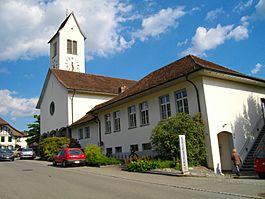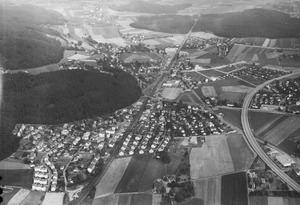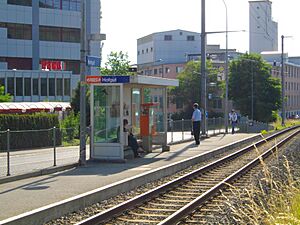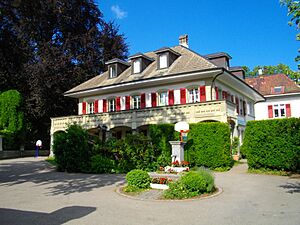Muri bei Bern facts for kids
Quick facts for kids
Muri bei Bern
|
||
|---|---|---|
 |
||
|
||
| Country | Switzerland | |
| Canton | Bern | |
| District | Bern-Mittelland | |
| Area | ||
| • Total | 7.63 km2 (2.95 sq mi) | |
| Elevation | 558 m (1,831 ft) | |
| Population
(Dec 2020 )
|
||
| • Total | 13,182 | |
| • Density | 1,727.7/km2 (4,474.6/sq mi) | |
| Postal code |
3074
|
|
| Surrounded by | Allmendingen, Belp, Bern, Kehrsatz, Köniz, Ostermundigen, Stettlen, Vechigen and Worb | |
Muri bei Bern is a lovely town, also called a municipality, in Switzerland. It's located in the Bern-Mittelland area. This area is part of the canton of Bern. Muri bei Bern is a great place to learn about Swiss history and nature.
Contents
- Discovering Muri bei Bern's History
- Exploring Muri bei Bern's Geography
- Muri bei Bern's Coat of Arms
- People and Life in Muri bei Bern
- Important Places in Muri bei Bern
- Religion in Muri bei Bern
- Muri bei Bern's Economy
- Education in Muri bei Bern
- Famous People from Muri bei Bern
- Images for kids
- See also
Discovering Muri bei Bern's History
Muri bei Bern has a long history! The town of Muri was first mentioned way back in 1180. It was called Mure then. The nearby village of Gümligen was first written about in 1239.
Even before these dates, people lived here. In 1832, old objects were found at Schlosshügel. These finds showed that Muri was settled during the time of the Roman Empire. The first official record of Muri was in 1180. It was about a clergyman named Burkhard doing business.
Back then, Muri was part of the Geristein area. In 1298, the city of Bern took control of Geristein. This area included Muri and three other parishes: Bolligen, Stettlen, and Vechigen. Even as Bern grew, it allowed these towns to manage themselves. This started a long tradition of local independence.
For many centuries, the people of Muri lived quite peacefully. Big changes in Europe and Switzerland didn't affect them much. But in the early 1900s, things started to change. Industrialization began, and trains connected the city to the countryside. Between 1920 and 1930, the town's population grew a lot. It went from 2,435 people to 3,938, which is a 62% increase!
Exploring Muri bei Bern's Geography
Muri bei Bern covers an area of about 7.7 square kilometers (3 square miles). A good part of this land, about 26.2%, is used for farming. Forests cover another 21.9% of the area.
Most of the land, almost 50%, has buildings or roads. A small amount, about 1.8%, is rivers or lakes. The rest is land that can't be used for farming or building.
The highest point in Muri bei Bern is on Dentenberg Mountain, at 727 meters (2,385 feet). The lowest point is 508 meters (1,667 feet) near the Aare River.
The town is located on a raised area above the right side of the Aare River. It's part of the larger city area of Bern. Muri bei Bern includes two main villages: Muri and Gümligen.
In 2010, Muri bei Bern became part of a new administrative area. This new area is called Verwaltungskreis Bern-Mittelland.
Muri bei Bern's Coat of Arms
The official symbol of Muri bei Bern is its coat of arms. It shows a shield that is split down the middle. One side is black, and the other is white. Across the middle, there's a zig-zag line, like a castle wall. The colors and zig-zag pattern switch sides in the middle.
People and Life in Muri bei Bern
Muri bei Bern has a population of about 13,000 people. In 2010, about 12.4% of the people living here were from other countries. Over the past 10 years, the population has grown a little. More people moved in than moved out.
Most people in Muri bei Bern speak German. About 88.9% of the population speaks German as their first language. French is the second most common language, spoken by 3.0% of the people. English is third, spoken by 1.5%.
In 2008, the population was almost half male (48.3%) and half female (51.7%). Most people were Swiss citizens. About 18.2% of the people living in Muri bei Bern in 2000 were born there. Many others were born in the same canton (44.1%) or elsewhere in Switzerland (19.5%). About 13.1% were born outside Switzerland.
In 2010, children and teenagers (up to 19 years old) made up 17.8% of the population. Adults (20-64 years old) were 56.5%, and seniors (over 64 years old) were 25.7%.
The town has good public transport. There's a tram service called Bernmobil and a bus service from RBS.
The chart below shows how the population of Muri bei Bern has changed over time:

Important Places in Muri bei Bern
Muri bei Bern has some very important historical sites. The Hofgut and Gümligen Castle are listed as national heritage sites. This means they are very important to Switzerland's history and culture.
Fun Things to See and Do
- Aarebad Muri: This is a popular spot for swimming.
- Muri Castle: A beautiful castle that is privately owned.
- Gümligen Castle: Another privately owned castle.
- Hofgut: A large country estate.
- Villa Mettlen: Another lovely country estate.
- Muri Church: A historic Swiss Reformed Church.
- Auguetbrücke: A bridge built across the Aare River in 1836.
- Natural Protected Area: A beautiful natural area along the Aare River.
- Ferries: You can still find ferries between Bern and Thun along the Aare River.
Religion in Muri bei Bern
In 2000, many people in Muri bei Bern were Christian. About 16.4% were Roman Catholic, and 62.3% belonged to the Swiss Reformed Church. There were also smaller groups of Orthodox Christians and other Christian churches.
Some people followed other religions. About 1.57% of the population was Islamic, and 0.26% was Jewish. There were also people who were Buddhist or Hindu. About 10.52% of the population said they didn't belong to any church.
Muri bei Bern's Economy
Muri bei Bern is known for its strong economy. In 2003, it was ranked as one of the best municipalities for business in the Bern area. It's even known as a place with lower taxes within the canton.
The town is always looking for ways to grow its economy. New areas are being developed for businesses, especially around Gümligen Station and Gümligen Field.
In 2011, the unemployment rate in Muri bei Bern was very low, at 1.48%. This means most people who wanted jobs had them. In 2008, over 7,600 people worked in the municipality.
- A small number of people (25) worked in agriculture (farming).
- About 1,724 people worked in manufacturing and construction.
- The largest number of people, 5,907, worked in the service sector. This includes jobs like sales, transportation, hotels, finance, and healthcare.
Many people travel to Muri bei Bern for work. In 2000, about 4,999 workers came into the town, while 4,717 left to work elsewhere. This means more people come to Muri bei Bern for jobs than leave it. About 35.8% of workers used public transportation, and 41.9% used a private car to get to work.
Education in Muri bei Bern
Muri bei Bern has six primary schools for younger students. There's also a private school called the International School of Berne in Gümligen. This school teaches classes in English.
The community also has four preschool daycare centers, called Kitas. These centers care for children before they are old enough for kindergarten. Three Kitas are in Gümligen, and one is in Muri. There is also a new Cinedome with an amazing IMAX theatre in Muri.
In Muri bei Bern, many adults have a good education. About 40.8% have finished upper secondary education. This is like high school. And 24.7% have completed even higher education, like university.
The school system in the Canton of Bern starts with one year of optional kindergarten. Then, students go to primary school for six years. After that, they attend three years of lower secondary school. Students are grouped by their abilities. After secondary school, students can continue their education or start an apprenticeship (learning a trade on the job).
During the 2009–10 school year, 1,218 students attended schools in Muri bei Bern.
- There were 9 kindergarten classes with 176 students.
- There were 30 primary classes with 602 students.
- There were 15 lower secondary classes with 289 students.
Many students in Muri bei Bern are from other countries or speak a different language at home. This shows the town's diverse community.
Famous People from Muri bei Bern
Muri bei Bern has been home to several interesting people:
- Rudolf Maria Holzapfel (1874–1930): A psychologist and philosopher born in Poland. He was nominated for the Nobel Prize in Literature six times!
- Marthe Gosteli (1917–2017): A Swiss activist who fought for women's right to vote. She was also an archivist, meaning she collected and preserved historical documents.
- Etienne Jornod (born 1953): A Swiss businessman. He is the Chairman of the Board for big companies like Galenica (pharmaceuticals) and NZZ Mediengruppe (media). He lives in Muri bei Bern.
- Andreas Meyer (born 1961): A lawyer who has been the Chairman of the Management Board of the Swiss Federal Railways (SBB) since 2007. He also lives in Muri bei Bern.
- Joëlle Brupbacher (1978–2011): A Swiss mountaineer who lived in Muri bei Bern.
Images for kids
See also
 In Spanish: Muri bei Bern para niños
In Spanish: Muri bei Bern para niños













